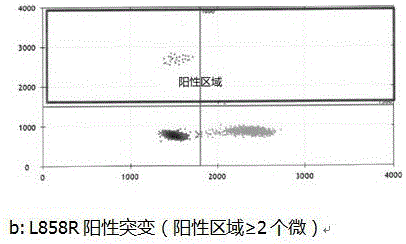Method of detecting EGFR (epidermal growth factor receptor) gene mutation in urine of colorectal cancer patient by using digital PCR (polymerase chain reaction)
A digital technology for colorectal cancer, applied in the direction of biochemical equipment and methods, microbial measurement/inspection, etc., can solve the problems of insufficient sensitivity and poor detection accuracy
- Summary
- Abstract
- Description
- Claims
- Application Information
AI Technical Summary
Problems solved by technology
Method used
Image
Examples
Embodiment 1
[0072] Take the detection of the L858R point mutation on EGFR exon 21 located at c.2573 as an example
[0073] The specific method is:
[0074] Step 1. Extract the DNA template in the urine:
[0075] a. Collect 40ml of urine samples from patients with colorectal cancer, centrifuge at 4°C and 5000rpm for 10min, and collect the sediment at the bottom after centrifugation;
[0076] b. Take 1.5 ml TE buffer solution and add it to the precipitate collected in step a. After mixing evenly, centrifuge at 8000 rpm for 5 minutes. After the centrifugation is completed, collect the precipitate at the bottom;
[0077] c. Take another 1.5 ml TE buffer solution and add it to the precipitate collected in step b. After mixing evenly, centrifuge at 8000 rpm for 5 minutes. After the centrifugation is completed, collect the precipitate at the bottom;
[0078] d. Take 500 ul of lysate and 10 ul of proteinase K and add them to the precipitate collected in step c. Under the condition of 55 ° C, ba...
PUM
 Login to View More
Login to View More Abstract
Description
Claims
Application Information
 Login to View More
Login to View More - R&D
- Intellectual Property
- Life Sciences
- Materials
- Tech Scout
- Unparalleled Data Quality
- Higher Quality Content
- 60% Fewer Hallucinations
Browse by: Latest US Patents, China's latest patents, Technical Efficacy Thesaurus, Application Domain, Technology Topic, Popular Technical Reports.
© 2025 PatSnap. All rights reserved.Legal|Privacy policy|Modern Slavery Act Transparency Statement|Sitemap|About US| Contact US: help@patsnap.com


